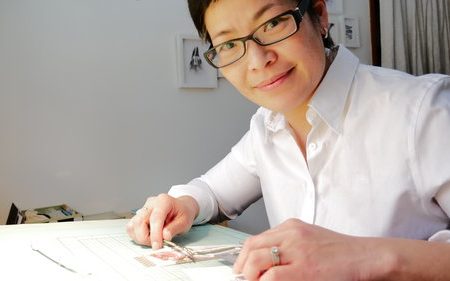You came to Canada when you were 19 from Oluanpi in the Pingtung Province, a fishing village in Taiwan where you were surrounded by mountains, water and nature. How has the visuals of nature influenced the aesthetic of your paper works?
Through natures vibrant colours and the incredible wonders that nature provides everyday.
In that same village, you said there was a famous snake museum that closed its doors and released all the venomous snakes into the surrounding wilderness of your village, making your daily walks potentially life threatening. When you came to Canada, you learned English from working as a waitress as a means to communicate with others and begin your new life. You also told me that you often hold your breath when making your sculptures, while intricate pieces are taped perfectly into place. Has your artwork helped you survive in the face of adversity, and do you consciously meditate on methods of control that you’ve learned in your life when making these time-consuming paper sculptures?
The snake museum was a something passed down from previous generations and it may not even be true. I think it was something the older generation told us as kids to explain all the poisonous snakes around us.
I believe I am able to do the intricate paper weaving now at this time in my life because there is not much in the way of adversity. I do not feel the need to find an escape but rather the effort and concentration to cut and connect the small stands of paper is relaxing, as strange as that may sound. I think a lot of my methods of controlling my breathing when putting the stands of paper together comes from my bike riding. When I am riding my bike I am always aware of my breathing and I think this awareness just carries over to anything I do.
Can you describe the difficult the student piece that you made while at the NBCCD, that started your belief in artwork-making as a painful practice?
I really did not have a name for the piece but it was a 10-yard piece, 45 inches wide, with 67 threads per inch. The Japanese weaving technique I used for this piece is called IKAT. This style is also referred to as Kasuri. This is the technique in which individual lengths of yarn are hand dyed prior to weaving. I always like to do challenging pieces, mostly because making something that is difficult is hard to replicate and it allows for unique one of a kind piece. Honestly what I find most painful in my work is when I am creating a piece and it seems too simple. I seem to always strive to make a piece more complex than it probably needs to be but my nature is to make that piece look simple even though it was incredibly challenging to connect it, fold it, or tape it in place.
What textile techniques have you mastered before and after your studies that still influences your process today?
I don’t think I have mastered any particular method of textile artistry (lol). I do however draw upon all my skills that I learned in college to create my one of a kind pieces. I am lucky enough to have the patience and guts mixed in with some training and raw talent to try something and visually see what the outcome might be even before it is finished. This allows me to try new ways to manipulate the paper into my vision and what I think will inspire other people to take an interest in my work.
In the paper works Shell We Dance, Rituals and Blue, you’ve woven very thin strips of paper cut from magazines into designs that are improvised as you weave. The results are undulations and geometry that pop off the background. They are at once freeform and immensely measured. Can you tell us from where this tension has come, to at once be obedient to the materials with which you work, but also allow yourself to elaborate as you create?
Well the colour and texture of the paper really guide how creative I can be with each piece. A piece of paper for example may have an excellent thickness for bending or manipulating so I can give my creation depth, but the colour combination I am using may strike me as a piece that is now one dimensional. As I look through the pages of a magazine I am first struck by the colours and as I start to get ideas for a piece then I take notice of the paper thickness. This is where I start to wonder how much I can manipulate a strand of this paper to give my creation depth so that is leaps out at the viewer, or how I can achieve the same effect using just colours to keep the piece flat and one dimensional.
What’s Next?
Well with one of a kind pieces you never know. For me it will always be trying to one up myself on ways to take a page from a magazine and see what I can do with it that I have not done before!
